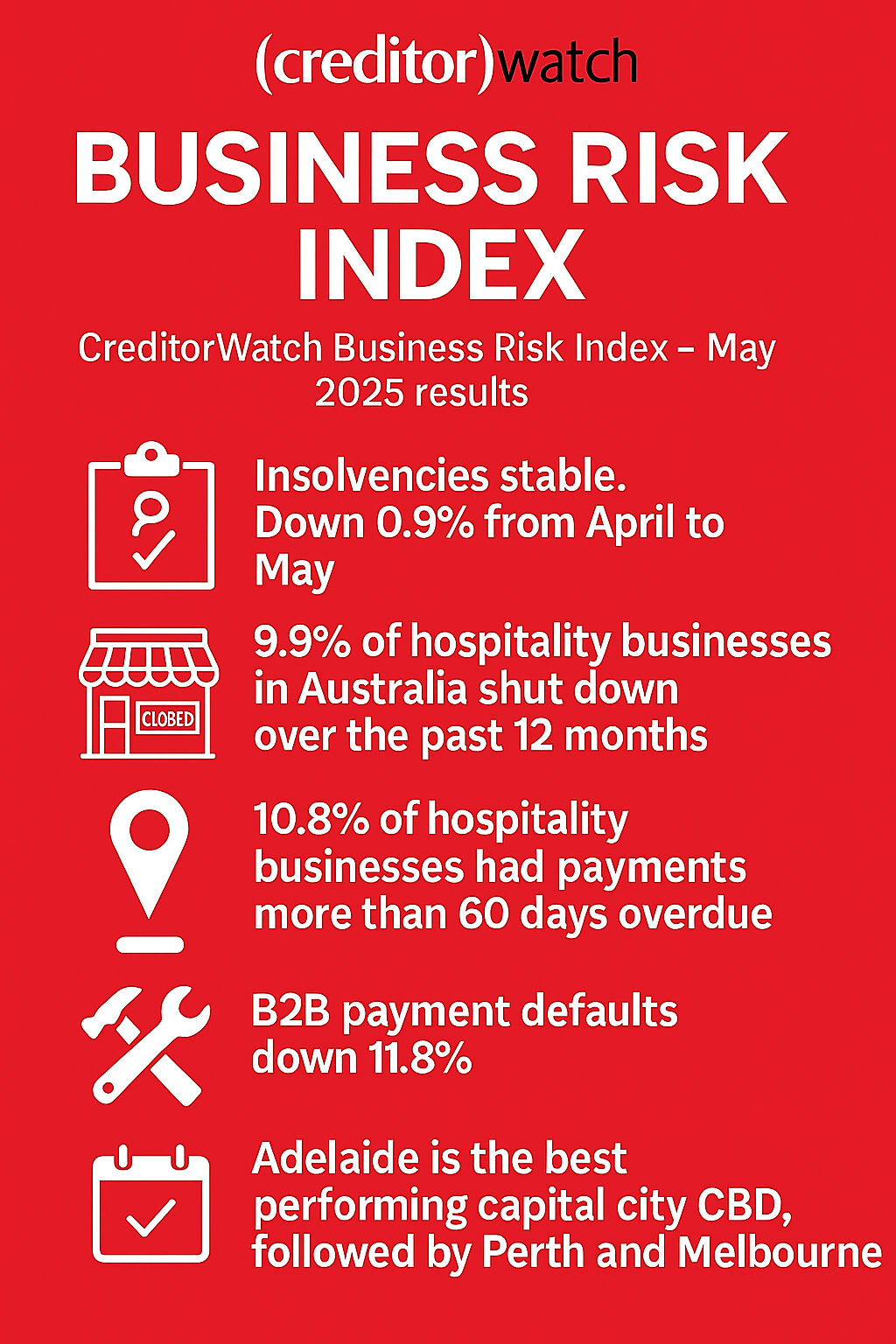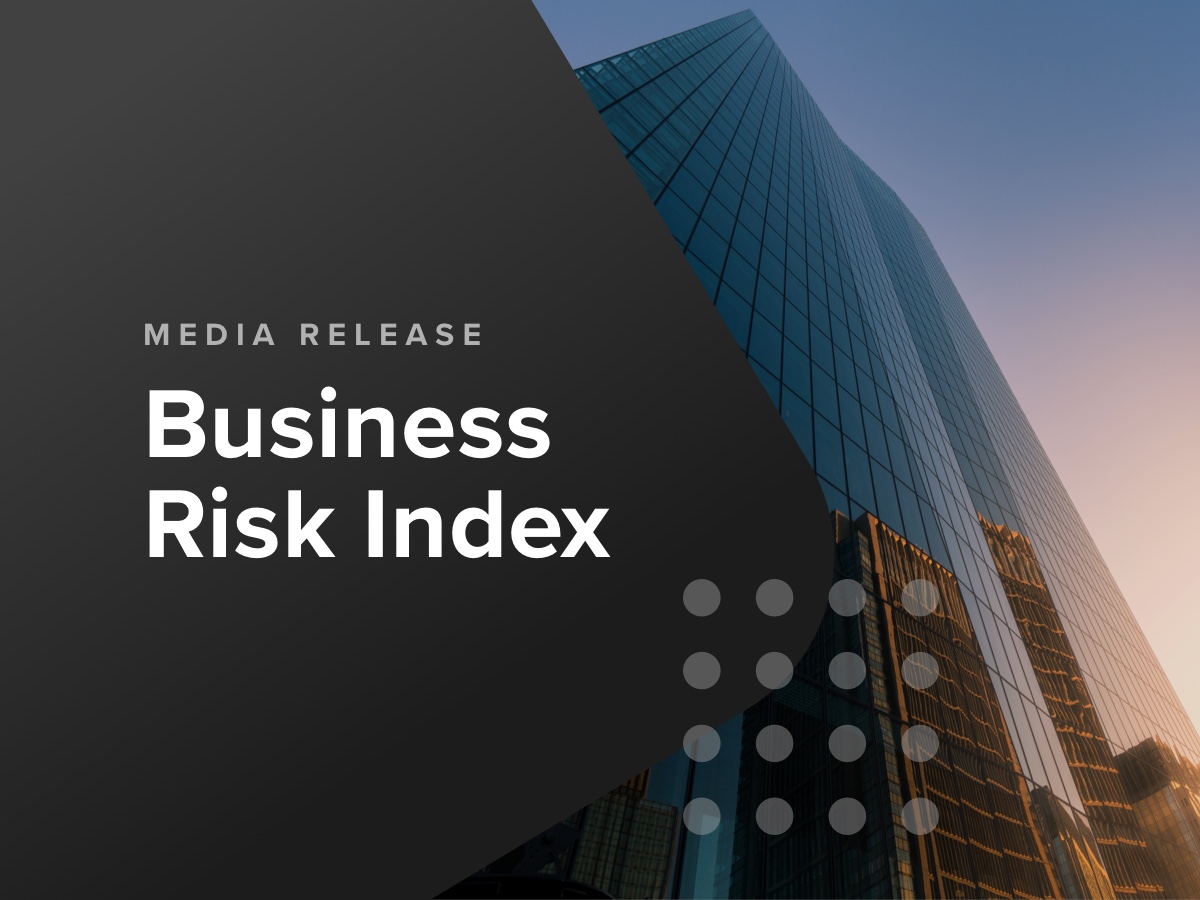
CreditorWatch, has released the May results for its Business Risk Index (BRI), revealing the worst could be over for Australian businesses, with key data hinting at a brighter outlook.
Creditorwatch’s May data shows an easing in two key measures of business stress, insolvencies and B2B payment defaults, suggesting the July 2024 tax cuts, recent interest rate reductions, slower inflation and fiscal support measures are beginning to alleviate some pressures on Australian businesses.
Insolvencies are down 0.9% from April to May and have now dropped 12% from their November peak. B2B payment defaults dipped 11.8% in May and are down 18.3% from their peak in December.
As CreditorWatch has been noting in recent months, insolvencies and trade payment defaults have levelled out, albeit at quite elevated levels. This suggests some of the pressures on businesses from higher costs and constrained consumer spending may be beginning to be balanced out by the favourable impacts of last year’s income tax cuts, other cost-of-living support measures, the start of interest rate relief and a slower rate of cost increases.
That’s a helpful backdrop as businesses negotiate the additional uncertainties emanating from US trade and tariff policies.
Easing insolvency trends have been evident in the two previously most challenged sectors: Accommodation and Food Services (Hospitality) and Construction – but Manufacturing and Wholesale Trade have also stabilised or declined somewhat. These favourable trends have more than outweighed rising insolvencies being recorded in Administration and Support Services; Healthcare and Social Assistance; Professional, Scientific and Technical Services; Retail Trade; Transportation, Postal and Warehousing; and Rental, Hiring and Real Estate.
Companies entering insolvency for the first time
Seasonally adjusted

Data sources: CreditorWatch, ASIC, Macrobond
Similarly, B2B invoice defaults appear to have stabilised in recent months, confirming the plateauing in insolvencies. Declines have been recorded in Construction; Food and Beverage Services; and Retail.
B2B payment defaults
Seasonally adjusted

Data sources: CreditorWatch, Macrobond
CreditorWatch CEO Patrick Coghlan says the May data on defaults and insolvencies is encouraging but some sectors remain under pressure.
“This levelling off of insolvencies has been long awaited and is very welcome but we need to remember that several industries still face significant challenges, particularly those exposed to discretionary spending.
“Post-COVID, we’ve seen inflation hit 30-year highs. Those rapid price increases across the economy don’t reverse when the inflation rate comes down again – the higher prices are locked in and remain as permanent pressures for businesses. They’re generally passed on to consumers, but this is very difficult for businesses in sectors such as hospitality. If the price of a sandwich at a café goes up by three or four dollars, people can very easily go elsewhere or bring their lunch from home.
“We won’t see conditions improve sustainably for businesses in discretionary sectors until consumers see their wages grow ahead of costs for some time.”
CreditorWatch Chief Economist Ivan Colhoun says, the Fair Work Commission’s decision to increase the National Minimum Wage from 1 July 2025 will benefit consumers but apply further pressure on businesses, particularly in Retail and Hospitality.
“The good thing is that we will likely see these funds recycled into the economy. Interest rate relief by the RBA, as inflation has moderated, should also improve cash flow a little for both consumers and businesses alike.
“One aspect we are watching as insolvencies pressures switch from Construction and Hospitality to other services sectors, is whether there is the possibility for greater impact on the broader macro-economy. A striking feature of the prior rise in insolvencies has been the degree to which small companies, particularly those employing less than five people and sole traders have been impacted.”
ANALYSIS OF HIGHEST RATES OF ARREARS
The challenges of the Construction and Hospitality sectors are well known and unsurprisingly are also reflected in elevated levels of arrears. Electricity, Gas, Water and Waste Services occupies the second highest level of arrears, which may be somewhat surprising given the essential nature of many of these services. While insolvencies in this sector remain relatively low, they have risen a little in recent times.
On closer inspection, the elevated level of arrears and moderate uptrend in insolvencies appears to reflect some of the pressures also afflicting the Construction and Hospitality Sectors. Two sub-sectors, Waste Services and Solar Installers have been under pressure, likely reflecting the combination of the softer residential construction cycle along with perhaps some more cautious consumer attitudes.
Looking ahead, the beginning of the rate cut cycle suggests the challenging conditions in these sub-sectors should begin to ease over the next six to 12 months as residential construction begins to recover.
Payment arrears 60+ by industry
12 months to May 2025

Data Sources: CreditorWatch trade receivables data (accounting software integration)
Payment arrears 60+ by industry
Top 3 industries

Data sources: CreditorWatch trade receivables data (accounting software integration), rate of 60+ arrears avg 12 months to 31 May 2025
Insolvency rate – Solar installers vs national average
May 2022 – May 2025

Data sources: CreditorWatch, ASIC, Macrobond
ANALYSIS OF HIGHEST AND LOWEST RISK REGIONS
The May Business Risk Index paints a stark picture of regional divergence across Australia, with Western Sydney remaining as the country’s most vulnerable business hotspot. All six of the nation’s worst-performing regions are in Sydney’s west, where high commercial rents, above-average personal insolvencies and lower-than-average household incomes are putting businesses under intense pressure.
In Bringelly-Green Valley, the average business closure rate is forecast to hit 7.89% over the next 12 months – the highest in the country. In contrast, the outlook is far brighter in inner-city Adelaide, where Norwood-Payneham-St Peters boasts the lowest business risk in Australia, with a projected closure rate of just 4.51%. Other low-risk areas are concentrated across regional Victoria and North Queensland, signalling greater resilience outside the major urban pressure zones.
Among capital city CBDs, Adelaide leads the pack again with the lowest forecast business failure rate (5.15%), followed by Perth (5.22%), Melbourne (5.81%), Brisbane (5.83%), and Sydney (6.24%).
CREDITORWATCH’S OUTLOOK
CreditorWatch Chief Economist Ivan Colhoun says the most recent trends have reflected a stabilisation to slight improvement in the pressures impacting on Australian businesses in the early months of 2025. Looking ahead, while looking ahead, conflicting pressures remain. Favourably, interest rates reductions should benefit both businesses and consumers as will the slower rate of inflation. Working in the other direction are the drag on world growth from US trade and tariff policies along with slower Australian population growth. The latter suggests at least two to three further interest rate reductions are likely, perhaps more if there is any suggestion of emerging weakness in employment.
The RBA is likely to enact its next interest rate at its July meeting. The May NAB Business Survey was disappointingly weak, although the extent this might reflect uncertainty to earlier higher US tariffs is hard to tell. In isolation the report might suggest the RBA should step up the size of its interest rate cut to a 0.5% reduction to prevent any greater moderation in economic growth occurring, though temporary tariff uncertainty may also unwind somewhat in coming months. That’s the uncertainty the Board will have to deal with in around three weeks’ time.
CreditorWatch’s recently published FY2026 survival guide contains a more detailed economic outlook: https://go.creditorwatch.com.au/fy26survivalguide
Subscribe for free here to receive the monthly Business Risk Index results in your inbox on the morning of release. No spam.

Get started with CreditorWatch today
Take your credit management to the next level with a 14-day free trial.
